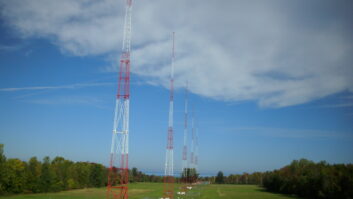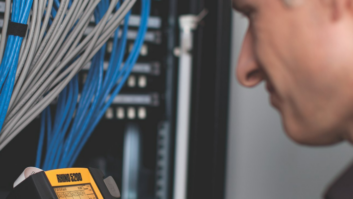
i456 cardioid microphone In just a short time, the Apple iPhone and its myriad Android cousins have changed the face of personal communications, gaming, photography, portable computing … and now audio recording for radio broadcast.
Radio reporters are using smartphones in the field as recording devices for collecting nat sound, conducting interviews and — with the proper app — editing and mixing files down for delivery. Quite often, portable USB Flash recorders are being left behind at the station in favor of the speed and portability of smartphones.
But what has been generally lacking in this arrangement has been a decent microphone. There has to be a better way to acquire good audio than by awkwardly pointing a phone at a subject, especially when there are multiple reporters in your way.
Cobbling together an adapter for a standard EV 635 mic isn’t always a good solution, and there is the hassle of figuring out the pin out of those odd four-connector 3.5 mm plugs.
Which is where the MicW product line steps in. Part of BSWA Technology Ltd. of China, MicW offers multiple microphone products and adapters for audio acquisition, all designed primarily for use with the iPhone, iPad and other mobile devices.
The once-over
MicW products all are electret condenser-style units, phantom-powered by the smartphone’s audio jack. No batteries — other than that of your phone — will die unexpectedly and botch a recording. Mics come in both omni and directional patterns, and all are precision-made and offer wide frequency response.
I have limited my review to a portion of the MicW lineup, concentrating on specific requirements: cardioid (directional) response for rejection of off-axis sounds, a sturdy mic mount to avoid damaging the phone or the connector when used in hostile conditions and decent audio specs that hopefully come in better than the phone’s internal mic.

iShotgun, shown with iPhone It should be noted the company offers one mic — the i436 — which is a flat-response omni mic best suited to audio analysis. Good to know about and probably handy in the lab, but not really suited for gun-and-run field audio.
i266
First out of the box is the model i266 ($169.99 kit, $129.99 mic only), a high-sensitivity mic surprisingly hefty; it’s about twice the weight and diameter of other MicW models.
This mic comes in a plastic case with locking lid, a robust metal tube for storage, extension cable and headphone adapter. You can connect it right to your phone’s audio jack and record on the fly, or use the included lapel clip and pop filter to pin the mic to the clothing of your interview subject.
The frequency response chart packed with this mic shows some peakiness around 10 kHz and 16 kHz, and a long bass rolloff starting around 600 Hz downwards. This is confirmed audibly (if not scientifically) in test recordings made on an LG smartphone running the RecForge Lite audio app.
A recording made with this mic is going to sound much like what you might hear in TV news audio: articulation of consonants will be fine but with little punch in the region where human vocal energy is the greatest (below 300 Hz). This response is not much different from what you might find in a typical lavalier-type mic, so you shouldn’t be expecting RE20 response.
I found the polar pattern description generous in referring to this mic as cardioid. Side rejection is minimal, and rear response is at best passable. If you’re going to use this mic, try to use it in a quiet area.
Also, the published specs indicated an S/N ratio of “more than 55 dB.” I would rather see about 65 to 69 dB as a starting point, much like what is offered by something like the Audio-Technica AT831R lavalier.
The slightly narrower i456 ($159.99 kit, $119.99 mic only) was next in my testing. Half the weight and radius of the i266, and packed in the same case and tube as the previous model, the i456 turned in a slightly lesser performance. Bass rolloff began as far up as 900 Hz and the highs jumped off a cliff starting just below 8 kHz, with a little blip up around 4 kHz.
Getting fancy
One mic kit in the collection that caught my eye is the i855 lavalier kit ($209.99). Packed with an assortment of adhesive pads, clips and a few pop screens, this MicW product is meant for sit-down, serious interviewing where the mic is pinned to the talent rather than stabbed into the end of the phone for a grab-and-go actuality.

MicW i855 (it’s in there!) and its accessories Response on this mic is generally what one would expect from a standard lav mic: rolloff starting around 200 Hz and a brightness bump around 12 kHz, but nicely flat in between. But like the i456, reports of its performance as a cardioid mic are somewhat exaggerated, charting more like an omni.
The cable between the mic and plug is thin and oddly stiff, for anyone used to using lav microphones. Manufacturers like Countryman also use very thin cable on its tiniest mics, but the cable typically has a little more give to it. Whether this impacts on its durability and function remains to be seen.
Top dog honors has to go to the iShotgun mic kit ($249.99). Packaged in a foam-lined locking plastic carry case, this mic is designed more for smartphone video acquisition than radio ENG, but is just the edge needed to lift a mic above a crowd of reporters to get close to the action.
Low-frequency response cuts off between 80 and 100 Hz, so street rumble and A/C noise are somewhat tamed. A lift centered around 3.5 kHz helps with clarity without being shrill, and the longer shotgun body helps with directionality. The specs state “super cardioid” and it does indeed have better rejection than the other models tested.
The kit also comes with a shockmount ring that can mount to a camera shoe, and a clever telescoping wand and cable that lifts the mic a full yard in the air for those out-of-shot (or above-the-crowd) pickups.
Using all the accessories in this kit is too cumbersome for gun-and-run audio, but the beauty of the MicW line is that you can connect anything directly into your phone, point and record, without all the extras. But this is the most versatile of the bunch.
If you have not had experience with a shotgun mic, be aware that you need to be pointing your mic directly at your subject. They don’t call them shotguns for nothing, and an errant bump in the arm or a moment of distraction that takes you off-axis will be quite obvious during playback.
Conclusions
MicW microphones fulfill a need for accurate, clear-sounding smartphone-oriented microphones in the smartphone era. Manufacturing is top-notch, with well-finished metal bodies instead of fragile plastic ones.
The designers outdid themselves on several fronts. First, they crafted the metal storage tube used in several of their products to pull double-duty as a safety case and a mic clamp to allow mounting to a stand (with a threaded adapter, not included). This is the kind of inventiveness one might find in an Ikea product.
Second, mic kits are packed with a headphone/mic splitter that let you plug in a set of buds to listen in on your recording. And most are also bundled with a 6-foot cable to extend the reach of the mic off the phone — although now mechanical handling noise of the mic becomes an issue.
Product Capsule
MicW I Series
Thumbs Up
+ Fills a need for accurate mobile audio recording
+ Compatible with Apple, Android and Windows devices
+ Small size and well manufactured
+ Accessory kits with adapters, cables and lapel clips in some models
Thumbs Down
– Directionality and frequency response less than ideal in some cases
Prices: i266 ($169.99 kit, $129.99 mic only); i456 ($159.99 kit, $119.99 mic only); i855 lavalier kit ($209.99); iShotgun mic kit ($249.99)
For information, contact MicW in Washington state at (425) 635-8117, email [email protected] or visit www.micwaudio.com.
The plug end of several MicW microphones is fairly wide and may not fit the 3.5 mm jack on your mobile device. Assuming the jack is not recessed, the problem is likely a too-narrow hole in the cellphone cover. Buying a new protective cover, or spending two minutes with an X-Acto knife, solves that problem.
I realize mic design can only go so far, but if there were a way to improve the directionality and S/N specs on these models, the engineers should pursue it. As smartphone audio acquisition becomes more of a standard process, the demand for better audio will not be far behind.
If it were up to me, I would probably go with the iShotgun, with a tossup between the i266 and the i855 lavalier. The 266 mounts right to the smartphone or pins to a lapel and I don’t have to worry about a thin cable flexing out on me; but I like the audio specs on the 855 just a tiny bit more.
Depending on the model and brand of smartphone in use, audio acquisition may be a breeze or a bother. One popular manufacturer decided to mount the audio jack at the bottom of the phone this year, making it awkward to point a mic and watch the display at the same time.
Finally, don’t let the accessories affect your purchase decision. The idea is to reduce the amount of gear we go out the door with, and a bag filled with goodies may slow you down. Being able to record, edit and upload via smartphone is an enormous time- and budget-saver; no sense bogging it down with pieces we may not need.
Alan Peterson, KJ4IVD, is an SBE-certified audio engineer, a longtime RW contributor and production director for the Radio America Network in Arlington, Va. Contact him at[email protected]












